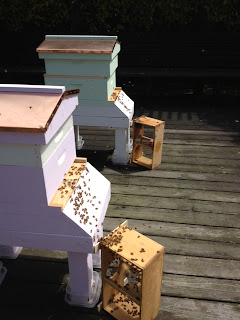The two packages of bees that I ordered from the
Beekeepers Guild of San Mateo County are coming this weekend! Unfortunately I'll be in Seattle, but a friend of mine said she'd install my packages for me (thanks Vicky!). So I'm preparing my hives so they'll be ready for this weekend. I had 10 frames of wired wax leftover from last year that I am putting into the bottom brood boxes of the new hives. I marked them with Xs because I've heard that the wax only foundation doesn't go into honey extractors very well (also why I'm putting them in the bottom boxes, so they'll be used for brood, not honey).
Here is what a wired wax frame looks like, the foundation is only wax and it is held up by a few wires:
Here is what my other frames look like, they have duragilt foundation in them (which has a thin piece of plastic that is coated in wax, it also has a metal binding down the sides):
After putting all of the frames in the hive bodies, I put one medium hive body on each and placed them outside in their new location on the deck. The new location is much sunnier than last year (in the side yard where the bees really only got early morning sun).
I also got a new deck box to store my bee equipment in. I put my tools, some feeders, and some extra hive bodies in there:

